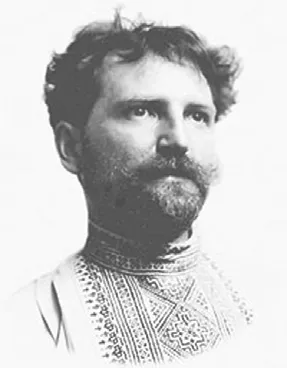“Job” Cigarette Paper《“乔布”卷
2018-04-02爱艺
译/爱艺

阿尔丰斯·穆夏(1860—1939)是捷克“新艺术运动”画家和装饰艺术家,以其独特的艺术风格闻名于世。
[2]穆夏出生于摩洛维亚小镇伊梵尼切(在现捷克共和国境内),成长过程中深受两大文化影响:一个是天主教,另一个就是斯拉夫民族摆脱奥地利帝国统治、实现民族独立的渴望。镇上教堂一处巴洛克风格的壁画激起了穆夏的艺术兴趣,后来他搬至维也纳做了一名舞台布景画师,开始学徒生涯。他以帮人画肖像维持生计。这份活计让他结识了重要的资助人库恩-贝拉希伯爵,伯爵雇请他为艾玛霍夫古堡绘制壁画。1894年,穆夏为歌舞剧《吉斯蒙达》制作海报,由此一炮而红。该剧主演莎拉·伯恩哈特是国际知名女演员,正是因为认识了她,穆夏也迅速成名。伯恩哈特与他签下一纸合约,他按约为伯恩哈特制作了多幅推广海报,还负责设计服装和舞台布景。
[3]穆夏不仅创作了一系列画作、海报、广告招贴画和图书插图,还设计过珠宝首饰、地毯、壁纸和舞台剧布景,作品呈现的风格最初称为“穆夏风格”,后来人称“新艺术运动”。穆夏的作品常常刻画美丽健康的年轻女子,她们身着略呈新古典主义样式的飘逸长袍,经常置身繁茂的花丛中,有时头后饰以花环。穆夏借鉴了拉斐尔前派、汉斯·马卡特和日本木刻艺术,形成了自己独特的风格。他的画风自然而华丽,优雅而灵动,线条弯曲流畅,还配有拜占庭式的边饰、题字和画框。他的新艺术风格被世人竞相模仿。
[4]这幅令人印象深刻的招贴画《“乔布”卷烟纸》(彩色平版印刷,66.7厘米×46.4厘米,1896年)是为卷烟纸制造公司约瑟夫·巴尔杜公司所做的广告招贴。一个手持燃烟的美丽女子占据了画面中央,袅袅升起的烟气与女子那拉斐尔前派风格的卷发和商标JOB交织在一起。招贴画金色锯齿状边饰的灵感来自拜占庭镶嵌画,加之盘旋的烟气和厚重的紫色背景,营造出一种奢华而性感的氛围。在锯齿状画框富有韵律的线条映衬下,女子秀发与升烟的弯曲线条显得格外突出。毫无疑问,这个女子在吸烟,更别提多少还带有情色的意味,这样的行为为人不齿,因为那个时代的正派女子不会在公开场合吸烟。此外,她的长发瀑布般披散着,性感而大胆,那时的正派女子则都会把头发扎起。
[5]这些离经叛道的重要细节暗示,吸烟的女子或许轻浮放荡。她迷失于享乐中——很可能一丝不挂,微闭双眼,半带笑容,一副陶醉的样子。穆夏以圣徒般的喜悦之心描绘这个女子,目的是为一种日常用品做广告,这也显示出他完美融合艺术与商业的高超画技。他将凡常之物提升至具有神秘之美的境界。
[6]这也许是穆夏最知名的广告招贴画之一,其后更以各种形式印制了无数版推往国际市场。这幅招贴画确立了“穆夏女性”的代表形象——拥有一头格外浓密的大波浪卷发。□
Alphonse Mucha (1860–1939) was a Czech Art Nouveau painter and decorative artist, known best for his distinct style.
[2] Muncha was born in the town of Ivancice, Moravia, and raised in the shadow of two powerful cultural forces:The Catholic Church and the Slav’s desire for independence from the Austrian Empire. A baroque fresco in his local church piqued his interest in art, and he moved to Vienna, where he took an apprenticeship as a stage set painter. To make a living he executed portrait commissions. This led him to an important mentor, Count Khuen-Belasi, who hired him to paint murals in Emmahof Castle.Mucha shot to fame in 1894 with his theatre poster for Gismonda. The leading actress, Sarah Bernhardt was an internationally famous, and by association with her, Mucha quickly became famous as well. Bernhardt put him under contract, and Mucha created many promotional posters for her, as well as costumes and stage sets.
[3] Mucha produced a flurry of paintings, posters, advertisements, and book illustrations, as well as designs for jewellery, carpets, wallpaper, and theatre sets in what was initially called the Mucha Style but became known as Art Nouveau. Mucha’s works frequently featured beautiful healthy young women in flowing vaguely Neoclassical looking robes, often surrounded by lush flowers which sometimes formed haloes behind the women’s heads. Drawing from the influences of the Pre-Raphaelites,Hans Makart1汉斯·马卡特(1840—1884),19世纪奥地利学院派历史画家、设计师,对奥地利后代画家影响深远。, and Japanese wood cuts,Mucha developed his unique style. His style was organic and ornate, graceful and dynamic, with curving, swooping lines and Byzantine borders, lettering,and frames. His Art Nouveau style was often imitated.
[4] This striking poster, “Job” Cigarette Paper (Colour lithograph, 66.7 cm × 46.4 cm, 1896), was created as an advertisement for the Joseph Bardou Company, the manufacturer of cigarette papers. A beautiful woman with a lighted cigarette dominates Mucha’s poster, the rising smoke intertwining with her swirling, Pre-Raphaelite hair and the logo—the trademark “JOB”.The poster’s golden zigzag border, in-spired by Byzantine mosaics, combines with the twirling smoke and the rich purple background to create a luxurious and sensual mood. The curving lines of the woman’s hair and rising smoke stand out against the rhythmic lines of the zigzag frame. The very fact that this woman is smoking—let alone that she is somewhat eroticized—was scandalous,since no respectable woman of the time would smoke in public. Furthermore,her sensual tangle of cascading hair was daring, because respectable women of the era wore their hair tied up.
[5] These significant breaks from tradition suggest that the smoker may be wanton and wild. She is lost in pleasure—quite possibly in the nude, her closed eyes and half smile suggesting ecstasy. Mucha depicts his smoking woman in the manner of a rapturous saint to advertise an everyday product, thereby revealing his great skill at blending art and commerce. He elevates the ordinary to a realm of mysterious beauty.
[6] This is perhaps one of Mucha’s best-known advertising posters, with numerous editions subsequently published in a variety of formats for international markets. This poster established the iconic image of the “Mucha woman” with her swirls of exaggeratedly abundant hair. ■
